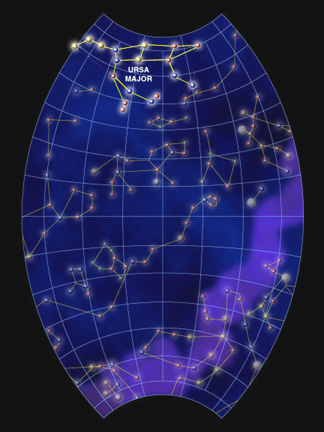Word of the Day
URSA (UR-suh)
Ursa Major: constellation visible in the northern hemisphere
Ursa Minor: constellation colloquially known as the Little Dipper
Common clues: Bear in the stars, Celestial bear; ____ Major (Great Bear); ____ Minor
Crossword puzzle frequency: 5 times a year
Frequency in English language: 58349 / 86800
News: A visit to the celestial zoo
Video: Find Ursa Major, the Big Dipper
Ursa Major is a constellation visible throughout the year in the northern hemisphere. Its name means Great Bear in Latin, and is associated with the legend of Callisto.

Its seven brightest stars form a famous asterism known in the United Kingdom as the Plough, and was formerly called by the old name Charles's Wain ("wain" meaning "wagon") as it still is in Scandinavia, Karlavagnen. This common Germanic name originally meant the men's wagon (the churls' wagon) in contrast to the women's wagon (Ursa Minor). There is also a theory that it was named after Charlemagne. In North America it is commonly known as the Big Dipper, because the major stars can be seen to follow the rough outline of a large ladle, or dipper; this is recognized as a grouping of stars in many cultures throughout the eras. In Hindu astronomy, it is referred to as Sapta Rishi meaning "The Seven Sages".
From the bowl to the handle, the stars in the Big Dipper are called Dubhe, Merak, Phecda (or Phad), Megrez, Alioth, Mizar, and Alkaid (or Benetnash), and are given Bayer designations of Alpha to Eta Ursae Majoris, in that order. Mizar has a companion star called Alcor, just visible to the naked eye, which served as a traditional test of sight.
Several galaxies are found in Ursa Major, including the pair M81 (one of the brightest galaxies in the sky) and M82 above the bear's head, and M101, a beautiful spiral northwest of η Ursae Majoris. The constellation contains about 50 galaxies, most of which are below 10th magnitude.
History
It was one of the 48 constellations listed by Ptolemy.
This is one of the most widely-known constellations, having been mentioned by such poets as Homer, Spenser, Shakespeare, and Tennyson. The Finnish epic Kalevala mentions them, and Vincent Van Gogh painted them in his painting Starry Night Over the Rhone.
When slavery was still allowed in the southern part of the United States of America, slaves wishing to escape to the Yankee North were advised to "follow the drinking gourd," or the circumpolar constellation of Ursa Major, towards freedom.
Trivia: The Big Dipper is not a constellation but a conspicuous part of a constellation (Ursa Major). The Big Dipper is a star pattern known as an asterism.
This article is licensed under the GNU Free Documentation License. It uses material from the Wikipedia article "Ursa Major".
|
|